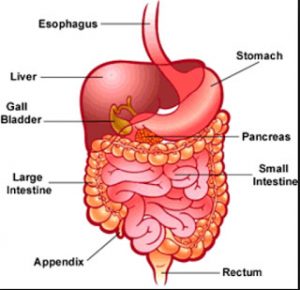Question 1 What is the function of bile?
Question 2 What is the role of hydrochloric acid in digestion?
Question 3 What is the function of salivary glands?
Question 4 What are the functions of pancreas?
Question 5 What are the function of liver?
Question 6 Describe the process of digestion in human beings?
Question 7 Draw a neat labelled diagram of human digestive system?
Question 8 Name the two hormones secreted by pancreas?
Question 9 What is peristaltic movement?
Question 10 What is absorption of food?
Question 11 What is assimilation of food?
Question 12 What is egestion of food?
Contents
5 Steps in the Process of Nutrition in Animals

(1) Ingestion
The process of taking food into the body is called Ingestion(mouth)
(2) Digestion
The process in which the food containing large, insoluble molecules is broken into small, water soluble molecules is called digestion.
(i) The mouth cavity contain teeth, tongue, salivary glands.
(ii) Teeth help in physical digestion i.e. cutting, chewing and grinding.
(iii) Salivary glands produce saliva and tongue help in mixing saliva with food.
(iv) Human saliva contain enzyme salivary amylase (digest starch present in the food into sugar)
(v) Food then goes to oesophagus or food pipe.
The walls of food pipe contain muscles which can contract and expand alternately. The contraction and expansion movements of walls of food pipe is called peristaltic movement.
(vi) Stomach is a J shape, lies on the left side of abdomen, food is churned in stomach for 3 hrs. The food breaks into still smaller pieces and form semi solid paste. The stomach wall contain 3 tubular glands in its walls. The gland secrete gastric juices (HCl, pepsin, mucus).
HCl provides acidic medium for various enzymes and chemical reaction.
(a) It makes gastric juice acidic so that pepsin function.
(b) It kill any bacteria which enters stomach with food.
Pepsin is an enzyme that breaks down proteins into smaller peptides.
(vii) Small intestine : It is 6.5 m long, it is called small because it is narrow, arranged in the form of a coil.
It receives secretion of 2 glands :
(i) Pancreas : It secretes pancreatic juices which contain digestive enzymes like trypsin, lipase, pancreatic amylase. The walls of small intestine contain glands which secrete intestinal juice. These juices help in the digestion of carbohydrates (glucose), proteins (amino acids), fats (fatty acids + glycerol)
(ii) Liver: It contains bile (it is a greenish yellow liquid, store in gall bladder, alkaline, contain salt which break fats).
It makes the acidic food coming from stomach alkaline so that pancreatic enzymes act on it.
Bile salts break fats into small globules so that enzymes can act on them easily.
(3) Absorption
The process in which the digested food(small and soluble) passes through the intestinal wall into blood stream.
The walls of small intestine contain capillaries. The inner surface of small intestine has million of tiny, finger like projections villi (provide very large surface area, which help in rapid absorption of digested food)
(4) Assimilation
The process in which the absorbed food is taken by body cells and used for energy, growth and repair.
The blood carries digested and dissolved food to all the parts of the body where it become assimilated as part of the cell. This food is used by cells for obtaining energy as well as for growth and repair. The digested food which is not used by our body immediately is stored in liver in the form of glycogen.
(5) Egestion
The process in which undigested food is removed from the body.
The undigested food passes from small intestine to large intestine. The walls contain villi which absorb water from undigested food. Due to this undigested food become solid. The undigested food is passed out through anus.
need all in one notes